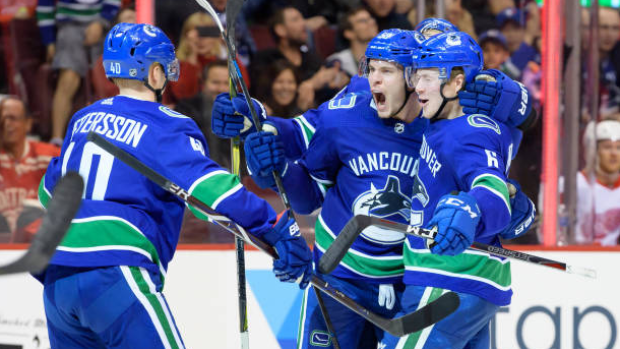Nov 25, 2019
Canucks making opponents pay on the power play
The Vancouver Canucks are mastering the ability to draw penalties and using their lethal power play to put themselves in a position to contend for a playoff spot, Travis Yost writes.
By Travis Yost

The only thing more dangerous than taking a penalty against a team with an electric power play is doing it over, and over, and over again over the course of a 60-minute hockey game.
That’s what Vancouver’s opponents have done all season long, and it’s one of the big reasons why the Canucks (12-8-4) have put themselves in a position to contend for a playoff spot through the first two months of the season.
We talked last month about how the top-line in Vancouver – generally featuring the combination of Elias Pettersson and Brock Boeser with a rotating cast of third options – had evolved into one of the most formidable trios in hockey under Travis Green’s oversight. But Pettersson and Boeser have also had a sizable impact on the power play. Vancouver’s power-play units have already scored 27 times in just 24 games – nearly double the league average and a whopping 20-goals above division rival Anaheim, who sit dead last in power play efficiency.
For good reason, the Canucks have been reticent to change it up on the man advantage. The duo of Petterson and Boeser are the two focal weapons on the power play, with J.T. Miller and Bo Horvat in the distribution and play-making roles and young defenceman Quinn Hughes walking the blue line. With all five of these skaters on the ice, Vancouver is generating nearly 112 shots per 60 minutes (fifth, relative to rest of NHL) and scoring 13 goals per 60 minutes (first, relative to rest of NHL).

Going through video of Vancouver’s power play opportunities, one obvious takeaway is that the distributors do an exceptional job at creating time and space to set up passing lanes into the slot area for the shooting wingers. Vancouver doesn’t have the crash-and-bang net front guy to generate offence from right in front of the net, but they do have a couple of exceptional shooters who can generate high quality chances from the circles. HockeyViz’s shooting heat maps capture well where Vancouver’s offence manifests from, and it correlates well with what we see through video analysis:

That second layer – running from the left faceoff circle to the right faceoff circle – is where the majority of Vancouver’s power-play offence is generated. Get a goaltender moving east to west and have a couple of snipers who can pick corners with velocity, and you have plenty of scoring chances created from this area of the ice.
But what truly makes Vancouver’s power play a scary proposition for the opposition may not have anything to do with the personnel they deploy or the areas of the ice in which they generate their attack. Hidden in Vancouver’s 27 goals is the fact that no team has been on the power play more than the Canucks this season – the team has held the man advantage 101 times this season, ten more than Colorado (2nd) and 51 more than New York (31st). It goes without saying, but giving a lethal power play more than four opportunities per game is a tall order for penalty kills around the league.
It’s one of the reasons why we have long studied the hidden skill of drawing penalties, particularly at even strength. Certain players have a knack for an ability to draw a whistle, and generally it’s a combination of speed and skill that forces off puck defensive players into uncomfortable situations ripe for illegal plays.
Consider Vancouver’s skaters year to date in their ability to draw these penalties in the first place. For benchmarking: the average NHL defender will draw about 0.4 penalties per-60 minutes of even strength play, and the average forward will draw about 0.8 penalties per-60 minutes of even strength play.

Vancouver is an interesting case in that not every player on the roster is drawing penalties at an above average rate, but rather certain players – the wondrously talented Pettersson, the chippy Jake Virtanen, and even a more defensive-minded player in Brandon Sutter – exceptional at it. Pettersson was one of the league leaders in his rookie season and has already improved on that mark in 2019-20.
The Canucks roster is still a work in progress, but what you are seeing here is a team in the transition stages of returning to a competitive brand of hockey. Their core players have been outstanding this year at even strength, those same players are having a tremendous bit of success on the power play, and significant pieces of the roster have been great at linking the two together when it comes to drawing penalties against the opposition.
In a Pacific division that has seen a tremendous amount of shake-up from just last season, this recipe alone may be enough to start taking the Canucks seriously as a playoff contender.
Data via HockeyViz, Natural Stat Trick, and Evovling Hockey

